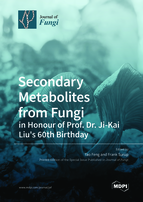Secondary Metabolites from Fungi—in Honour of Prof. Dr. Ji-Kai Liu's 60th Birthday
A special issue of Journal of Fungi (ISSN 2309-608X). This special issue belongs to the section "Fungal Cell Biology, Metabolism and Physiology".
Deadline for manuscript submissions: closed (30 April 2022) | Viewed by 66006
Special Issue Editors
Interests: natural product bioactivity; fungal natural products
Special Issues, Collections and Topics in MDPI journals
Special Issue Information
Dear Colleagues,
The Journal of Fungi is pleased to announce a Special Issue entitled Secondary Metabolites from Fungi in honor of Prof. Dr. Ji-Kai Liu on the occasion of his 60th birthday for his outstanding achievements in fungal chemistry—especially fungal natural products. This Special Issue is dedicated to all aspects of fungal natural product chemistry, including fungal natural product isolation, structural elucidation, bioactivity, synthesis, biosynthesis, etc.
Professor Ji-Kai Liu received his PhD degree from Lanzhou University in 1988 and is currently a distinguished professor at South-Central University for Nationalities, China. In 2002, he won the National Outstanding Youth Fund. In 2008, he became the chief scientist of the "973" program. His research results won the 2003 National Natural Science Second Prize, the CAS-Bayer Award, the 2007 and 2015 Yunnan Provincial Natural Science First Prize, and the Tan Jiazhen Life Science Innovation Award in 2009. The research team led by him has become one of the centers of advanced fungal chemistry and biological activity research in the world. The chemical composition of more than 300 fungal species has been studied. More than 3,200 different types of compounds have been isolated and identified, including more than 1000 new compounds. Through biological activity and pharmacological tests, it has been found that some compounds have significant biological activities such as anti-tumor, regulation of sugar and lipid metabolism, anti-HIV, and hallucinogenic. Many molecules are currently under evaluation as candidate drug molecules.
The purpose of this Special Issue is to pay tribute to the significant contributions in these fields of Professor Ji-Kai Liu and provide some important recent advances in theory, methods, and applications. We cordially and earnestly invite researchers to contribute their original and high-quality papers that will inspire advances in fungal natural product chemistry.
Prof. Dr. Tao Feng
Dr. Frank Surup
Guest Editors
Manuscript Submission Information
Manuscripts should be submitted online at www.mdpi.com by registering and logging in to this website. Once you are registered, click here to go to the submission form. Manuscripts can be submitted until the deadline. All submissions that pass pre-check are peer-reviewed. Accepted papers will be published continuously in the journal (as soon as accepted) and will be listed together on the special issue website. Research articles, review articles as well as short communications are invited. For planned papers, a title and short abstract (about 100 words) can be sent to the Editorial Office for announcement on this website.
Submitted manuscripts should not have been published previously, nor be under consideration for publication elsewhere (except conference proceedings papers). All manuscripts are thoroughly refereed through a single-blind peer-review process. A guide for authors and other relevant information for submission of manuscripts is available on the Instructions for Authors page. Journal of Fungi is an international peer-reviewed open access monthly journal published by MDPI.
Please visit the Instructions for Authors page before submitting a manuscript. The Article Processing Charge (APC) for publication in this open access journal is 2600 CHF (Swiss Francs). Submitted papers should be well formatted and use good English. Authors may use MDPI's English editing service prior to publication or during author revisions.








